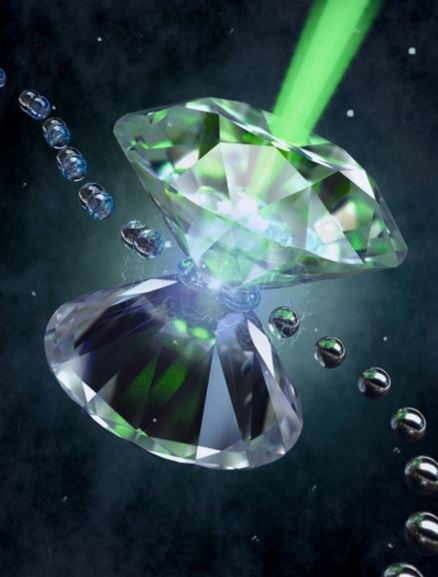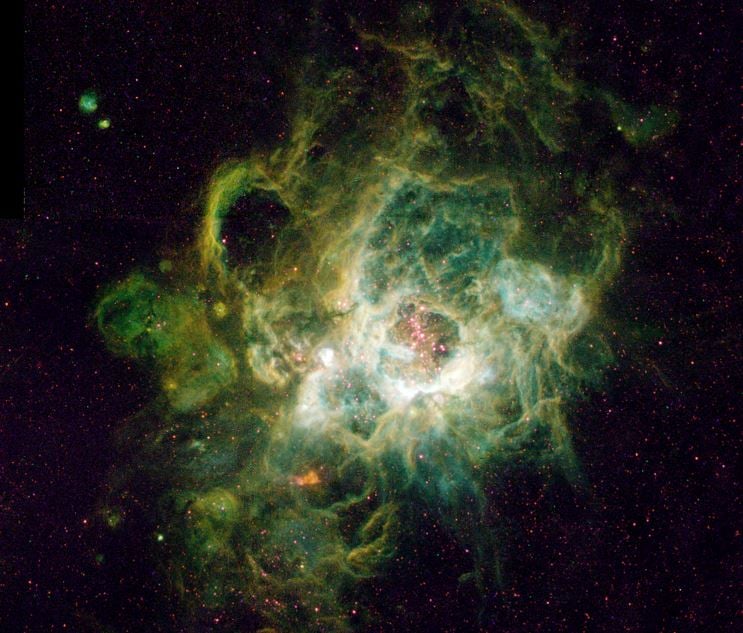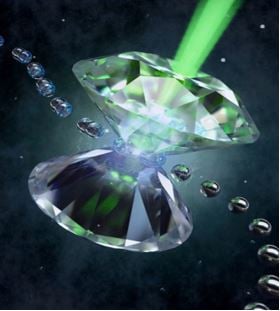The long-sought quest to form a new atomic, metallic, solid state of hydrogen has nearly been achieved by a team of scientists at the University of Edinburgh’s School of Physics and Centre for Science at Extreme Conditions, and the Institute of Solid State Physics at the Chinese Academy of Sciences.
Writing in the prestigious academic journal Nature, Philip Dalladay-Simpson, Ross T. Howie and Eugene Gregoryanz explain that nearly eighty years ago scientists had predicted that under enough compression, the H-H bond in H2 (molecular hydrogen) would break, forming a new, atomic, metallic state of hydrogen.
The authors say their experiments have reached the highest-ever recorded pressures on dense hydrogen – even greater than the pressures that exist in the centre of the Earth.
 An artist’s impression of the transition of hydrogen from a molecular to an atomic state. (Image: ph.ed.ac.uk)
An artist’s impression of the transition of hydrogen from a molecular to an atomic state. (Image: ph.ed.ac.uk)
In their study, they provide evidence that above 350 GPa (3,500,000 atm) and at room temperature H2 adopts a new structure (GPa stands for gigapascals. atm stands for atmosphere. One gigapascal = 9869.23 atm. The terms refer to degrees of pressure).
The precursor to metallic phase of hydrogen
The authors wrote:
“Interestingly the results are suggestive that this new phase could prove to be the precursor to the long sought metallic phase of hydrogen, predicted over 80 years ago by theory.”
Hydrogen is the simplest and most abundant element in the Universe. It is of fundamental interest in several fields of science. At very high pressure and low temperatures, it is predicted to transform from a molecular system to an atomic (metallic) state.
Scientists believe hydrogen exists in the centre of the gas planets (Jovian planets) including Neptune, Uranus, Saturn and Jupiter, and is the source of their extremely high magnetic fields. Hydrogen’s behaviour is crucial to planetary science.
Metallic hydrogen would lead to many tech breakthroughs
If humans managed to get hydrogen into this metallic state, which is superconductive and superfluid, there would be several technological breakthroughs.
 NGC 604, a giant region of ionized hydrogen in the Triangulum Galaxy. Hydrogen is the Universe’s most abundant chemical element, making up 75% of normal matter by mass and over 90% by number of atoms. (Image: Wikipedia)
NGC 604, a giant region of ionized hydrogen in the Triangulum Galaxy. Hydrogen is the Universe’s most abundant chemical element, making up 75% of normal matter by mass and over 90% by number of atoms. (Image: Wikipedia)
Reaching such conditions with hydrogen in the laboratory has been an enormous challenge in the field of high pressure research, the authors explain. Just four years ago, they had only managed to reach less than half of the pressure achieved in their latest experiments.
The scientists made new technological breakthroughs in the containment of hot hydrogen in diamond cell experiments, and with this technology found that above 350 GPa, hydrogen adopts a novel phase – Phase V.
They believe that Phase V is the precursor to the completely metallic and atomic phase of hydrogen.
Prof. Gregoryanz and colleagues believe their work will reinvigorate both theoretical and experimental efforts to understand these newly-discovered phases, and the evolution of the Universe’s most abundant element to a purely metallic (atomic) structure.
Prof. Gregoryanz said:
“The past 30 years of high-pressure research saw numerous claims of the creation of metallic hydrogen in the laboratory with the latest being made in 2011, but all these claims were later disproved.”
“Our study presents the first experimental evidence that hydrogen could behave as predicted, although at much higher pressures than previously thought.”
In an Abstract in the journal, the authors wrote:
“These experimental data provide a glimpse of the physical properties of dense hydrogen above 325 gigapascals and constrain the pressure and temperature conditions at which the new phase exists.”
“We speculate that phase V may be the precursor to the non-molecular (atomic and metallic) state of hydrogen that was predicted 80 years ago.”
Citation: “Evidence for a new phase of dense hydrogen above 325 gigapascals,” Philip Dalladay-Simpson, Ross T. Howie and Eugene Gregoryanz. Nature 529, 63–67 (07 January 2016). DOI: 10.1038/nature16164.
Video – One step closer to metallic hydrogen

